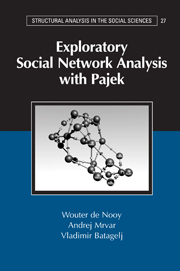Book contents
- Frontmatter
- Contents
- List of Illustrations
- List of Tables
- Preface
- Part I Fundamentals
- 1 Looking for Social Structure
- 2 Attributes and Relations
- Part II Cohesion
- Part III Brokerage
- Part IV Ranking
- Part V Roles
- Appendix 1 Getting Started with Pajek
- Appendix 2 Exporting Visualizations
- Appendix 3 Shortcut Key Combinations
- Glossary
- Index of Pajek Commands
- Subject Index
1 - Looking for Social Structure
Published online by Cambridge University Press: 05 June 2012
- Frontmatter
- Contents
- List of Illustrations
- List of Tables
- Preface
- Part I Fundamentals
- 1 Looking for Social Structure
- 2 Attributes and Relations
- Part II Cohesion
- Part III Brokerage
- Part IV Ranking
- Part V Roles
- Appendix 1 Getting Started with Pajek
- Appendix 2 Exporting Visualizations
- Appendix 3 Shortcut Key Combinations
- Glossary
- Index of Pajek Commands
- Subject Index
Summary
Introduction
The social sciences focus on structure: the structure of human groups, communities, organizations, markets, society, or the world system. In this book, we conceptualize social structure as a network of social ties. Social network analysts assume that interpersonal ties matter, as do ties among organizations or countries, because they transmit behavior, attitudes, information, or goods. Social network analysis offers the methodology to analyze social relations; it tells us how to conceptualize social networks and how to analyze them.
In this book, we present the most important methods of exploring social networks, emphasizing visual exploration. Network visualization has been an important tool for researchers from the very beginning of social network analysis. This chapter introduces the basic elements of a social network and shows how to construct and draw a social network.
Sociometry and Sociogram
The basis of social network visualization was laid by researchers who called themselves sociometrists. Their leader, J. L. Moreno, founded a social science called sociometry, which studies interpersonal relations. Society, they argued, is not an aggregate of individuals and their characteristics, as statisticians assume, but a structure of interpersonal ties. Therefore, the individual is not the basic social unit. The social atom consists of an individual and his or her social, economic, or cultural ties. Social atoms are linked into groups, and, ultimately, society consists of interrelated groups.
- Type
- Chapter
- Information
- Exploratory Social Network Analysis with Pajek , pp. 3 - 28Publisher: Cambridge University PressPrint publication year: 2005
- 1
- Cited by

